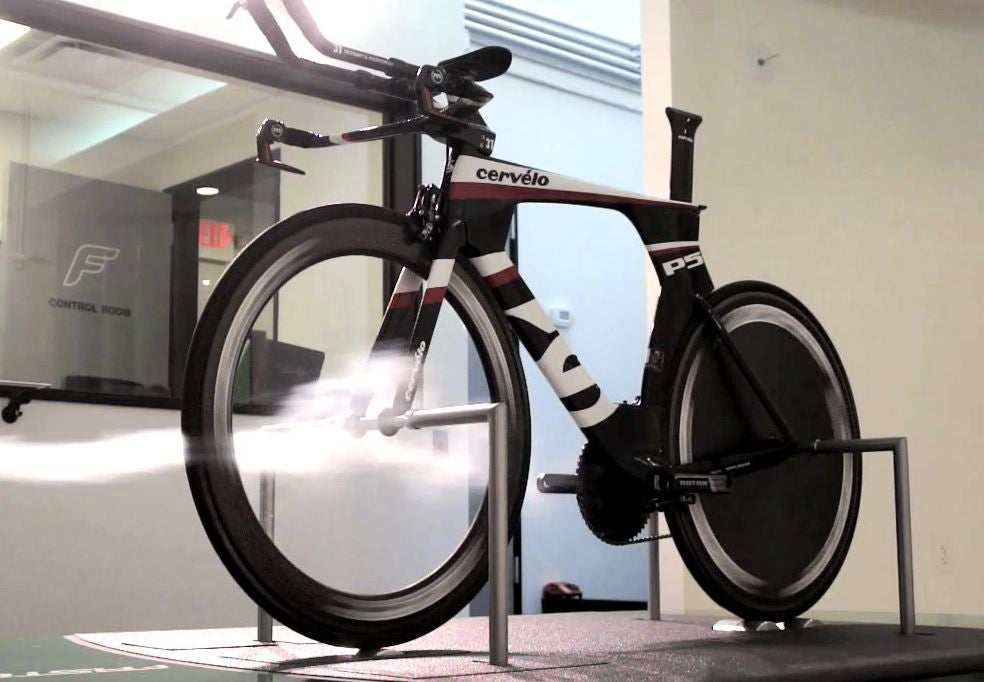Inside Triathlon: Drag Data Digest

These four bikes were tested across a wide range of yaw angles—from 20 degrees offset on one side to 20 degrees on the other—because cyclists experience many different wind angles on the road, even in light winds. We estimated the wind conditions that a triathlete is likely to experience to decipher which bike is fastest in real life and how much of a difference these bikes can make.
Wind speed impacts the wind angle experienced by the rider, which is a product of both rider speed and wind velocity, so we looked at weather data to find an estimate of typical wind speeds experienced in races across the country. 8.1 miles per hour was the average wind speed we found from data collected in 49 major cities from Seattle to Miami. Ideally, an athlete would measure real wind speed on each individual racecourse and run a calculation to find the drag they expect to face during a race then pick accordingly from their stockpile of race wheel. This is, of course, not practical for most athletes so we use this approximation.
The test was conducted in 30mph wind in order to magnify the differences between the bikes, but, since most of us ride far slower than 30mph, we scaled the drag down to a more realistic range. In addition to the amount of wind resistance, yaw angle also changes with rider speed (faster rider, shallower yaw; faster wind, wider yaw), so we calculated the fraction of time a rider would spend in various yaw angle ranges when riding at 23 miles per hour and weighted the drag created at each yaw angle accordingly. These were the results for a rider traveling at 23mph in 8.1mph wind.
Trek Speed Concept 9 Series: 435 grams
Cervélo P5 Three: 495 grams
Specialized S-Works Shiv: 525 grams
Orbea Ordu GDi2: 606 grams
What do these numbers add up to on the racecourse? Faster’s wind tunnel engineer Jay White uses a mathematical calculation to equate 100 grams of drag to 1 second per kilometer, regardless of rider speed. That equation creates the following time differences over an Ironman 70.3.
Trek Speed Concept 9 Series: Tunnel test winner
Cervélo P5 Three: +53 seconds
Specialized S-Works Shiv: +81 seconds
Orbea Ordu GDi2: +153 seconds
As stated in the printed article, the test is imperfect, as are all bike aerodynamic tests. Several factors—most notably the influence of a rider—could make the real life performance of these bikes different than the results of Inside Triathlon’s test.
17g
In order to generate the most accurate data possible, the protocol involved two precision checks. Taking two data points at each wind angle was the first check. The bike remained completely stationary and unchanged through this process—any different between the two data points is indicative of measurement error. Out of 44 pairs of data points, 17 grams at 30mph was the biggest discrepancy. This occurred while testing the Cervélo P5 at -20 degrees of yaw.
Taking three different zero points was the second precision check. Each bike test started at zero degrees of yaw, swept out to 20 degrees then stepped back to zero by five-degree increments before continuing out to -20 at five-degree increments. After the measurement at -20 degrees, the bikes were swept back to zero for the final data points. Ideally, the drag at each of the three zero degree measurements would be equal since the bike’s position was equivalent in each of the three measurements at zero. Any difference can be considered error. Most of the data points, all taken at 30mph, ranged between 300g and 625g. The differences between the largest and smallest drag measurements at zero degrees are as follow
Trek Speed Concept 9 Series: 18.5 grams
Cervélo P5 Six: 10 grams
Specialized S-Works Shiv: 28 grams
Orbea Ordu GDi2: 19.5 grams